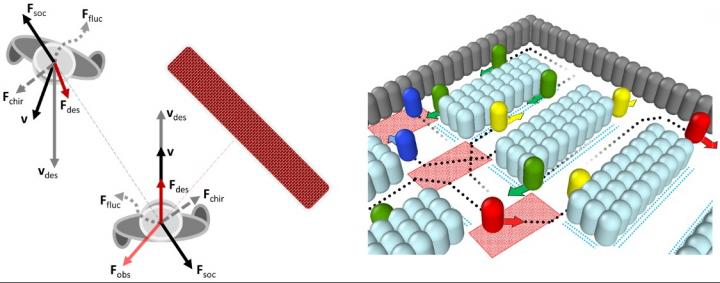
Credit: Skoltech
A Skoltech team has developed a model for assessing infection risks for supermarket customers. The researchers believe that their model will help formulate scientifically backed rules for safe shopping during the pandemic. The paper was published in PLOS One.
The team included professor Maxim Fedorov, who serves as Skoltech’s Vice President for Artificial Intelligence and Mathematical Modeling, and a research group led by professor Nikolai Brilliantov — the Director of the Skoltech Center for Computational and Data-Intensive Science and Engineering (CDISE).
The composite model presented in the paper incorporates a social forces model that describes customer motions and interactions with other shoppers or obstacles and is known to realistically reproduce waiting lines and congestions in confined spaces, such as stairs, and customers’ behavior during emergency evacuation. The approach is based on calculating several “forces” (see image), each describing a customer’s tendency to maintain a comfortable speed, approach a target, avoid obstacles, etc.
Other components describe the purchasing strategy and retail space layout. Customers are known to behave differently, depending on the place they visit: a small shop, a supermarket, or a cafe. The team used customer behavior scenarios specific to supermarkets and several layouts with varying numbers of intersections and bottleneck widths. Finally, the team proposed a model of infection transmission by virus-containing aerosol droplets.
The researchers used their composite model in multivariate numerical simulations to assess infection risks depending on several factors, such as average customer density, social distancing, behavior scenarios, use of masks, and retail space geometry. It turned out that the infection rate is primarily determined by social distancing, and to a much lesser extent, by the supermarket layout or customer strategy.
Curiously enough, the team discovered that increasing customer density has only a slight positive effect on sales, so filling the store to the limit makes little sense not just epidemiologically but economically, too.
“The functional version of our model, which we have made publicly available, can be used to assess the effects of various factors on the risk of infection. For example, you can optimize a store’s operations in the pandemic environment by controlling customer flow, relocating specific items, and reconfiguring the retail area. Although our selection of layouts did not reveal a noticeable effect of space configuration on infection spread, geometry may be an important factor in other cases,” Alexey Tsukanov, a co-author of the paper, comments.
###
Media Contact
Ilyana Zolotareva
[email protected]
Original Source
https:/
Related Journal Article
http://dx.




